Lessons B2B Brands Can Learn From Nike’s Marketing Strategy
If you are a marketer, you probably know that consumer behaviors and trends have changed over the years.
Marketing has become so complicated and sensitive that you have to be careful how you approach it.
As evidence, many CMOs say they are somewhat concerned about making missteps that may harm their brand image in these improbable times.
There hasn’t been a time when marketing has been so tricky. But, many companies, such as Apple and Nike, do marketing without overthinking.
Surprisingly, it works very well for them. Hell of a poker game, isn’t it?
Nike has used a unique strategy to be at the top of the game with no risk of being overtaken or eclipsed. And that’s true whether it’s a time of crisis or not.
But what makes Nike different?
In this article, I’ll show you how to do marketing that doesn’t look like marketing by giving you a glimpse into one of the biggest brand’s strategies and tactics.
You are certainly thinking that Nike is a B2C brand – which is true – but keep in mind that their marketing strategy can be applied to any B2B brand.
I love speculating. But, today, I will not. You’ll read the real facts behind a significant brand, the marketing strategies, and the tactics used.
About Nike
Everybody knows Nike. I bet even granny Betty does. Yet, very few people know what it is that makes the brand play in the big league.
Now, before diving into Nike’s digital marketing strategy and tactics, let me give you some statistics:
- Founded 55 years ago by Phil Knight and Bill Bowerman, Nike is the world’s most valuable apparel brand today.
- Nike has the largest market share in the North American sportswear industry (approximately 27.4% and, until recently, had an impressive 96% market share for basketball shoes) and continues to outpace the competition in sales.
- Nike’s Air Jordan brand of basketball sneakers generated more than $3.14 billion in the fiscal year ending May 2019, a 10% increase over the previous year.
- Ubersuggest shows that nearly 42 million internet users land on Nike’s website every month.

- Nike’s annual revenue continues to grow year after year. Some analysts predict that Nike’s revenues will grow by nearly 25% to the fiscal year 2021, reaching $45.4 billion.
- Despite its market leadership, Nike continues to spend more than $3 billion on marketing.
Impressive statistics, aren’t they?
Nike’s marketing strategy focuses on creating buzz through well-organized and targeted campaigns. As a result, every time Nike pulls a card out of its sleeve, it wreaks havoc.
Well, it’s because Nike has figured out what engages people. Emotions. Not much.
How to Generate Buzz by Appealing to People’s Emotions
Nike has devoted a lot of attention to content creation, focusing on its social media channels and video production to reach its new, digitally savvy audience.
And Nike is a pro at producing eye-popping videos!
With its creative use of advertising, Nike gives every race, gender, and generation in the world the sensation that they’re empowered.
Their marketing strategy is to empower people through compelling videos, ads that ooze culture, social freedom and constraints, fashion trends, lifestyle trends, opinions, messages, and love.
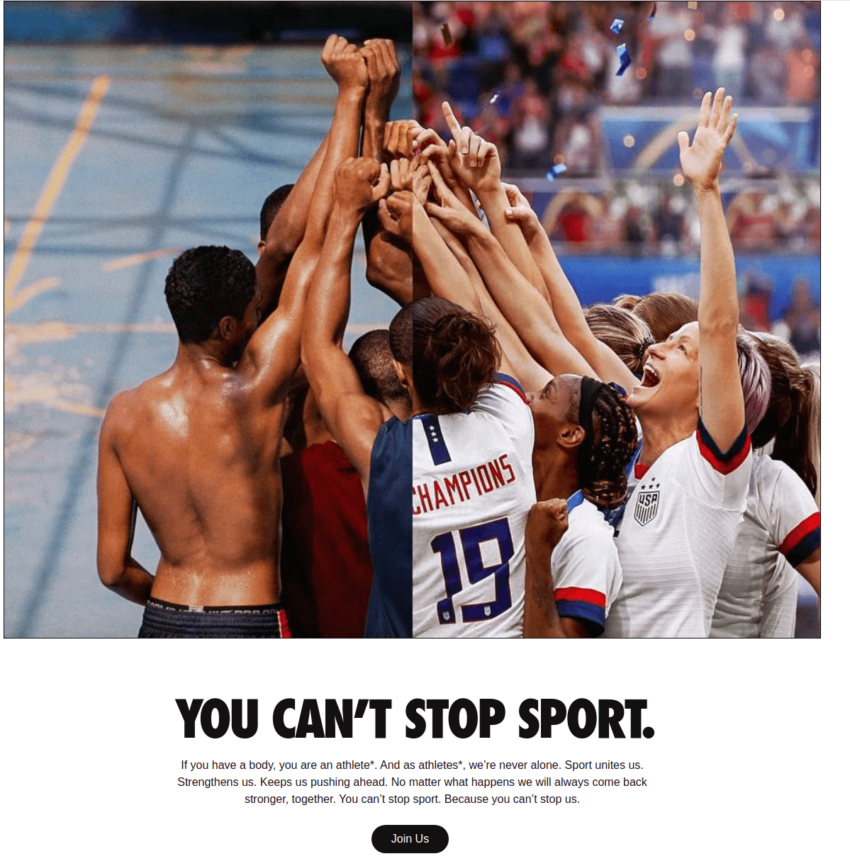
As a result, the majority of Nike’s advertising videos make tens of millions of views on YouTube.
They test the limits of their buyers’ personality by being so in tune with the world and offering them a release, a safe place, and the feeling of not being alone. They regularly produce video content that speaks effortlessly to their clients with sound, moving, and engaging stories.
But you’re still wondering: How does Nike make such engaging videos?
Here are some of the techniques Nike uses to create videos that attract millions of views.
- Storytelling
- Going beyond product marketing
- Not giving a fly about the competition
These are certainly part of what makes Nike’s videos great, but there are also other things to consider like the messaging and the community.
Storytelling
As the world shifts, so does the way companies need to talk about what outcome and experience they offer.
Many companies spend their time talking about the features and quality of their products.
Check how Adidas does it.
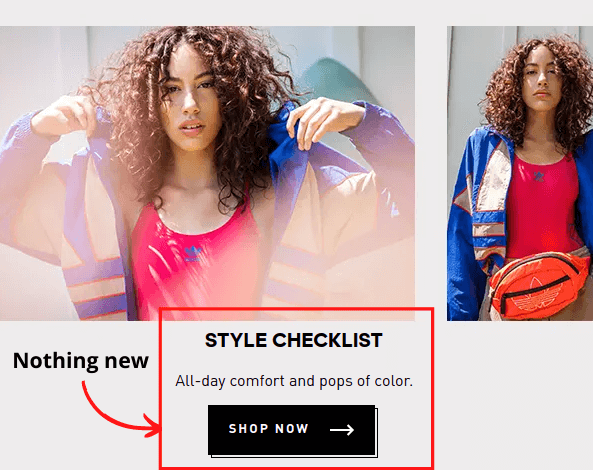
Here’s another one: “This computer has an i9 core processor and a 32GB ram.”
Rings a bell?
Well, thank you for quoting product specs. But how can your product help solve my problems?
That marketing technique only worked in the 90s!
Nike figured it out quickly and decided to leverage storytelling instead—telling stories that resonate with the needs, the problems of the buyers.
This is Nike.
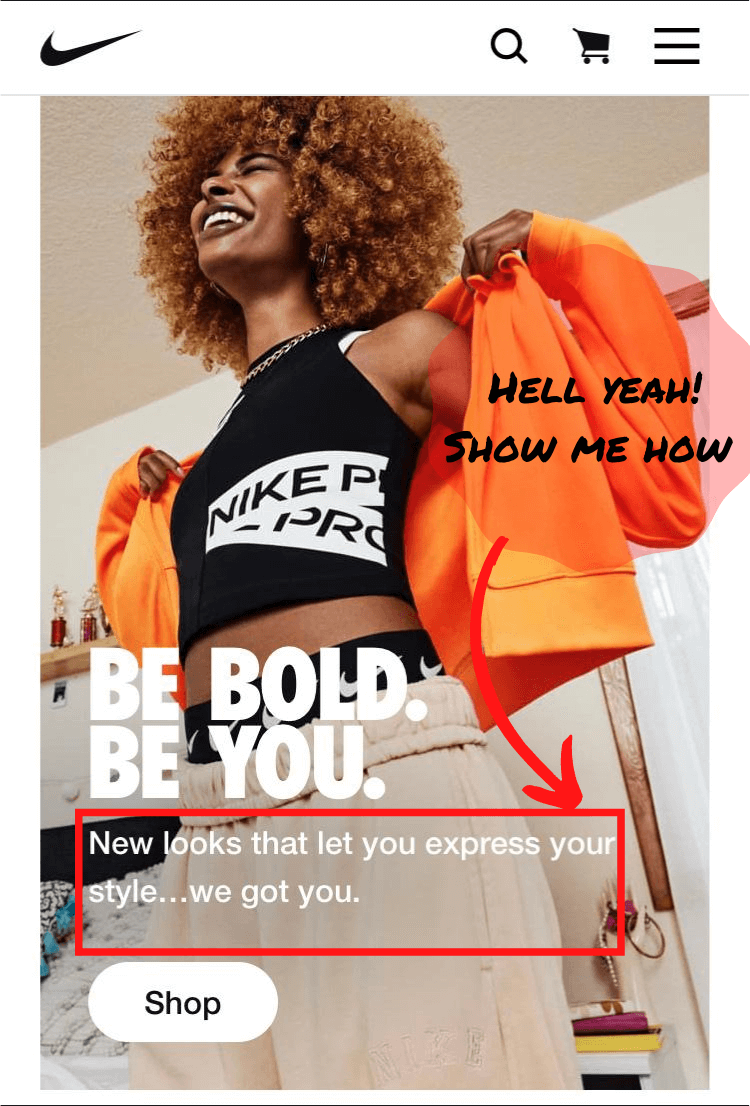
Nike is also well-known for telling stories that motivate, raise awareness, support minorities—even if they create scandals.
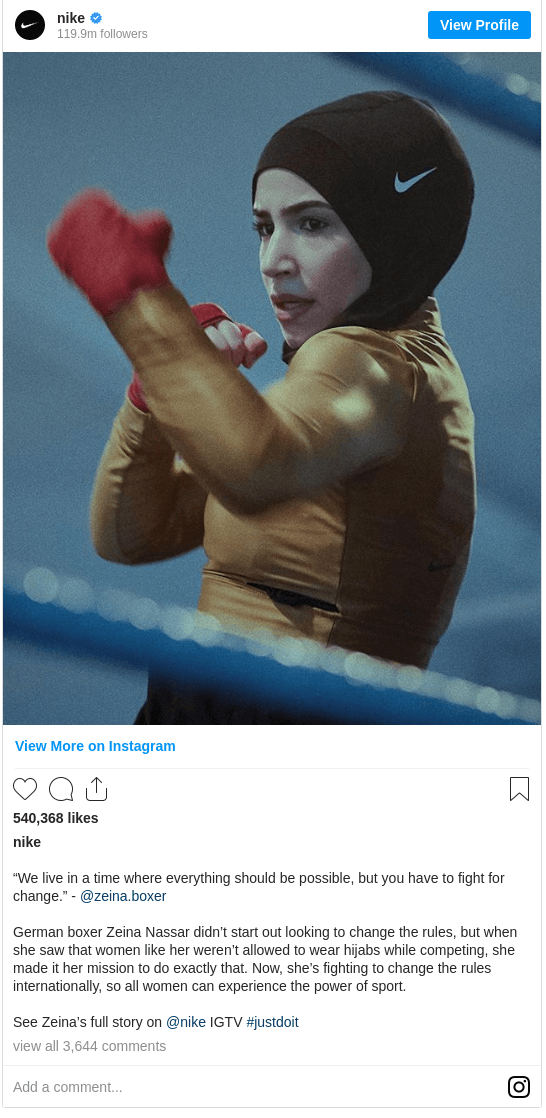
Marketing involves risks. And Nike is good at giving their brand big shots.
The brand has never been afraid to take a stand. And this is where most companies today fail because they’re worried about losing buyers.
The BIG fact is that millennials and Gen Zs are more willing to pay extra for the products and services of companies engaged in making a positive social and environmental impact.
Nike understands that its buyers—the majority of whom are under 36—are willing to put their money, time, and effort into their values.

Consumers don’t want athletes to shut up and dribble, and they don’t want shoe companies just to sell shoes; they require them to stand up for something they value.
Nike takes the matter seriously. Take a look at their “Just do it” campaign featuring former NFL player Kaepernick. Also, check out their “You can’t stop us” campaign, which has already earned over 40 million views on YouTube alone in one week.
But it’s not enough just to attack a problem. It’s about when, how, and why.
Many major brands have tried to adopt Nike’s marketing strategy on several occasions without success.
A real example is the Pepsi campaign featuring Kendall Jenner.
The campaign was about supporting a cause. But it was so badly staged that internet users accused Pepsi of trivializing the famous “Black Lives Matter” movement.
This leads to the conclusion that good storytelling must reckon the following factors:
- Timing
- Message
Timing
Knowing when to break the news is an art. And Nike is Leonardo Da Vinci.
The swoosh brand listens to the people and their problems. This means that when there’s a sensitive issue that affects a section of the population, Nike is in the know.
You would undoubtedly have noticed that the majority of Nike’s advertising videos deal with current affairs (even in times of crisis).
You may wonder, but why release a commercial video in the middle of a pandemic or a national social crisis?
Psychologists have proven that people are more likely to listen to experts and leaders in times of crisis. This means that what people want most is to listen to their favorite brands’ voices in times of crisis.
Unfortunately, in these times, brands are afraid to take a stand. So when Nike does, it attracts everyone’s attention, which results in more sales.
What I’ve learned from going through two crashes (the dotcom crash in 2000 and the real estate crash in 2008) is that the best time to double down is when others are not.
Here are some other important facts:
- When Nike launched its “Just do it” campaign with Kaepernick, its share price dropped to 3.2%. A week later, Nike’s stocks had escalated back to the same level it was before the announcement. Besides, an analyst has forecast this to continue for a 15% growth over the next year.
- Bloomberg also reports that in less than 24 hours after Kaepernick first tweeted the campaign, it created $43 million in Nike’s free advertising.
- Online sales also went up. According to some studies, after Labor Day weekend, sales grew 31% from Sunday to Tuesday, compared to 17% in the same period last year.
Who would have imagined that Kaepernick’s controversial campaign would generate such fabulous results?
The Takeaway: Never be afraid to make your voice heard in times of crisis because, contrary to what everyone thinks, this is when people will listen to you or expect you to speak.
Message
Well, every marketing campaign is about “conveying a message.” But the problem isn’t the message.
The problem is who’s at stake in the message. Does your message position you as a hero or a villain? Do people support your cause?
While getting your message across, you need to make sure that it unites rather than divides people—and that the right people back you.
Here’s how Nike hits home with their messaging:
- Finding common ground
In its campaign with Kendall Jenner, Pepsi wanted to champion a cause but conveyed the message in the wrong way.
Nike, in all its commercial videos, tries to see who is at stake in the story. Then the brand positions as the hero.
And you would’ve noticed, Nike is always there to give a voice to the voiceless.
In doing so, Nike says to everyone, “Hey, I’m your friend, not the enemy.”
We don’t do advertising anymore. We just do cool stuff. It sounds a bit wanky, but that’s just the way it is. Advertising is all about achieving awareness, and we no longer need awareness. We need to become part of people’s lives, and digital allows us to do that.
- Using Social Proof
As a marketer, you already know that the average consumer makes decisions based on social proof. (Whatever the channel, from paid ad to email marketing to SEO, you should make use of social proof to get good results.)
Nike’s spokespeople are probably the biggest names in the sports industry. From Roger Federer, Neymar, and Michael Jordan to Cristiano Ronaldo, to name but a few, the big names in the sport are affiliated with Nike.
By personifying the brand through these sports legends and putting their faces above the brand or their product, Nike has carved out a special place for itself in the world of sports.
But Nike chooses its ambassadors delicately. Nike doesn’t just jump on some “random” celebrity to launch a campaign.
- Kaepernick isn’t just a star. He defends a cause, the cause of black people abused by the police.
- Megan Rapinoe isn’t just some celebrity activist. She’s championing the cause of equal pay for male and female players.
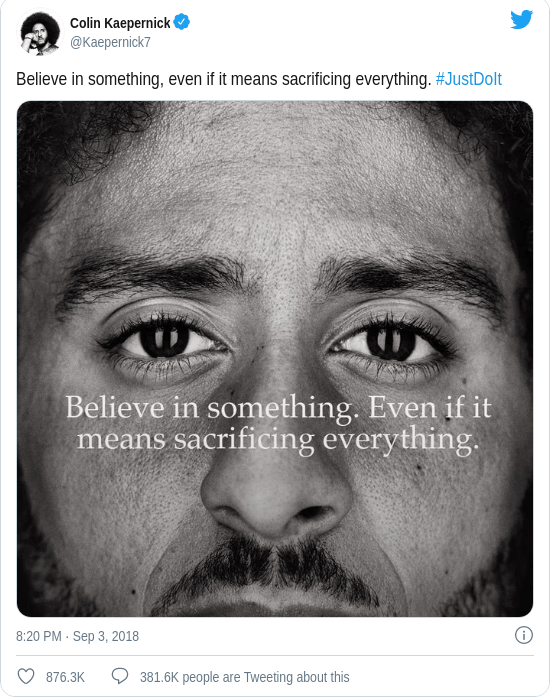
When Pepsi puts Kendall Jenner—who certainly isn’t known for her everyday struggles—upfront, it’s normal for the campaign to flop.
The Takeaway: The “message” is the most critical aspect of a marketing campaign. Most importantly, make sure your messaging is as meaningful as possible to your audience. Show them what you stand for. Also, don’t be afraid to bring out celebrities that your audience can relate to.
Going Beyond the Product
What puts companies like Apple and Nike above others is not necessarily the particularity of their product, but rather the philosophy around their brand.
Instead of the product being the centerpiece, Nike engages its audience with stories. (Just like we do here at RevGenius.)
Very quickly, Nike became less concerned about selling shoes (the product) and more about fitness. They didn’t want to sell you a shoe, but rather a mantra to be fit, active, and mostly to stay healthy (the story).

Nike shoes are sold as a way to stay in shape, and so the fact that they are comfortable to run in and more stylish to look at is just a detail.
Nike quickly became a fitness brand that sells an image, feeling, and lifestyle.
You’ll see it very often, at Apple and Nike, the majority of commercial videos do not promote a product, but a cause, a way of thinking, a philosophy. And this is what makes people think one brand is trustworthy and the other is not.
The problem with product-oriented marketing is that it’s boring and gives no reason to click on anything.
Enter Adidas’ website to see what product-oriented marketing looks like.

Meh…
The Takeaway: Customers don’t care what the features of your products are. So stop cluttering up your content with product specs. Instead, focus on the “CHANGE” it brings to the table—it’s an excellent way to trigger engagement. People buy change. Not product features.
Ignoring the Competition
Nike focuses primarily on direct sales to consumers. This marketing strategy demonstrates that Nike is a brand that follows people, is attuned to trends, and adapts instantly to cultural change.
The ultimate result is that the brand has been able to segment its audience according to their preferences and retain them.
A study conducted in 2018 reveals that Nike customers repeat purchase intentions are high, and experts believe this is a strong sign of loyalty.
With a total of 318 social media profiles covering many products and geolocation, Nike is one of the most followed brands online. The brand has broadened its online presence by creating separate product pages for different target audiences.
Above all, they focus on satisfying their customers rather than “wasting time” on the competition. And Nike ends up winning.
Competition is for losers.
Peter Thiel
The Takeaway: Figure out what your audience wants and focus on it. If you can meet your customers’ needs, even your competitors will become fans—always checking on what you’re doing.
Nike has social media profiles on all large platforms, such as Twitter, Facebook, YouTube, LinkedIn, and Pinterest.
Their content strategy is anything but rocket science. And they do not follow a consistent pattern in publishing content. Instead, the publishing frequency is topical, with Nike publishing frequently during its campaigns or around international sporting events featuring its brand ambassadors.
To understand Nike’s low frequency of posting, I delved a little deeper. It is interesting to note that from 836 posts in 2012, the brand has seen a sharp decline in Facebook content over the years, with only a meager 28 posts in 2015. Nike only posted four times a month in 2017 and gradually stopped posting after August 2018.
YouTube
Nike has more than one million subscribers. Interestingly, compared to its other social media profiles, Nike posted more frequently on YouTube, with the brand uploading 399 videos in 2017 alone.
Nike’s strategy on YouTube is primarily to showcase its products. Behind-the-scenes videos detailing product stories and manufacturing are an essential part of their video marketing on YouTube.
Campaigns also form a significant part of Nike’s YouTube strategy. This year, Nike promoted ‘You can’t stop us’ on YouTube. The video has 44 million views and over 5,000 comments in one week.
Comparing Nike’s YouTube feed to its largest competitor Adidas, Nike has uploaded more videos than Adidas (147). Their videos also received better engagement and positive feedback in terms of ratings and comments.
Nike holds the gold standard unmatched on Instagram. With an astonishing 119 million followers, Nike is the first most popular brand on Instagram.
During the period analyzed, the brand experienced the following growth of 119,546 on average.
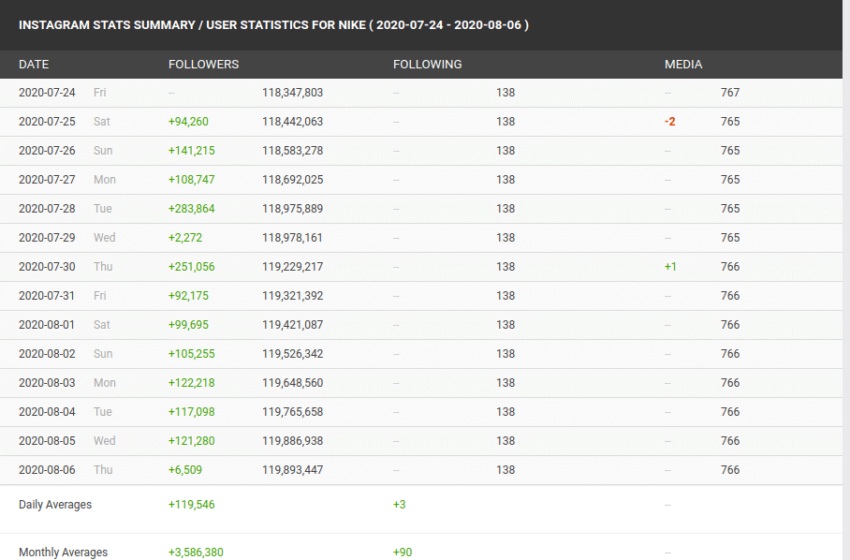
On Instagram, Nike received the highest number of engagement on its photos, representing less than 30% of the published content. The brand received the highest number of placements between 5:00 pm and 6:00 pm Eastern Time, with the posting frequency peaking at noon. Sunday was the most engaging day for the brand, which posted more content that day.
Who doesn’t want to learn from their hero? Nike celebrates its influencers and presents them as sources of inspiration. Cristiano Ronaldo, Roger Federer, Rafael Nadal, and artists such as Kendrick Lamar, Travis Scott, and Kevin Hart held the most important positions.
Nike’s partnerships with high-profile celebrities are reflected in the mentions they receive on Twitter.
Nike has also made a concerted effort for the “You can’t stop us” campaign on Twitter. They also ran several ads on Twitter for the event, targeted to specific geographic areas. Thirty-nine million people on Twitter alone saw the campaign.

Nike uses Twitter visibly to answer customer questions, with 96.8% of the brand’s tweets being responses. On average, Nike responded within 10 hours. Brand mentions peak between 11 am and 2 pm, while Nike most often responds between 12 pm and 1 pm. The brand responded most often on Tuesdays and Saturdays.

Nike also has a separate Twitter ID, @teamnike, dedicated solely to customer service. The average response time (ART) for @teamnike is 6 hours.
The brand responded from 11 am to 1 pm, with the response rate peaking at noon. Customer service is provided every day of the week, Saturday and Sunday, with an average response time of fewer than 3 hours.
Recap
- Go beyond your brand
Nike’s social media makes you want to get started in fitness! Nike’s brand identity is based on social, visually appealing content that showcases the Nike lifestyle.
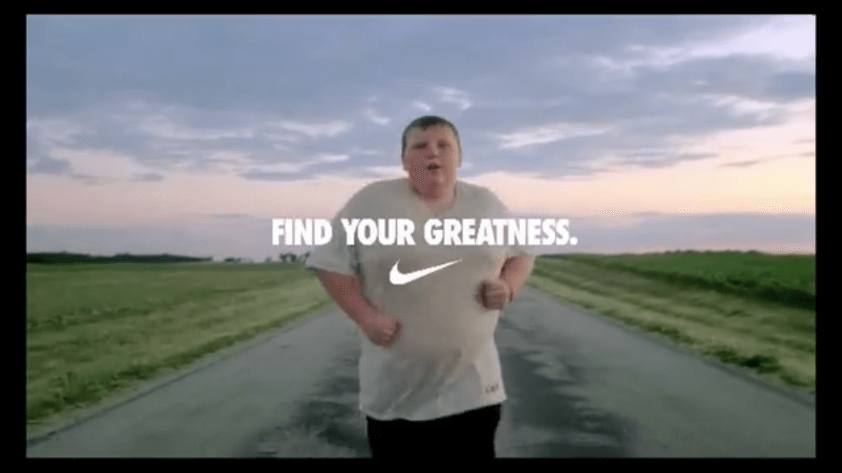
Instead of just selling the product, Nike takes a holistic approach to focus its brand identity on the concept of fitness and healthy living.
- Put quality above quantity
Nike does not clutter their social media pages with messages. It focuses on creating quality content and promoting it every time it publishes, rather than posting it frequently.
- Stand up for something
Nike is committed to telling stories that align with its consumers’ aspirations, goals, lifestyles, and dreams. Messages and stories that champion optimism and empowerment are an effective emotional branding exercise for Nike.
- Take marketing campaigns seriously
Nike makes every effort to promote its social media campaigns. They developed different strategies for different social channels and successfully used its offline campaigns to create much-needed hype.
- Keep your customers in mind
With its friendly and approachable attitude toward customers, Nike does not let its fans down. Their eagerness to streamline all discussions and complaints to their dedicated customer service channel shows the importance the brand places on its fans.
- Bet on sponsorship
We can credit much of Nike’s success to its sponsorship deals with professional sports’ most prominent names. Nike also leverages its leading social media influencers. The diversity of its influencers in different sports provides a credible and trusted voice for the brand.
Nike’s social media strategy and its effectiveness reflect the number of followers of the brand. Every brand can learn from Nike and emulate it.
Want to step up your marketing efforts like Nike? Reach out for 1-on-1 marketing help.